I still have not recovered, but if I don’t do this post soon I’ll have forgotten the whole trip:
Abu Dhabi: In a previous post, I said you should wait a couple years before going to Abu Dhabi. At the moment, I saw three notable places, the grand mosque, the palace, and the Louvre museum branch.
For most people, the mosque and palace are the most impressive sights—really stunning works of architecture. The more aesthetically-minded viewer might feel these two buildings are a bit excessive. I find it hard to evaluate huge modern examples of classical architecture, as without the patina of age they seem a bit artificial.
The mosque is roughly in the style of the Taj Mahal, but lacks its perfect proportions. Even so, it’s light years better than anything Vegas would do. The palace is slightly more subdued, but perhaps not as graceful.
The mosque is worth visiting twice, once in the daytime when the white marble gleams in the sun, and once at night when it has a blueish tint:
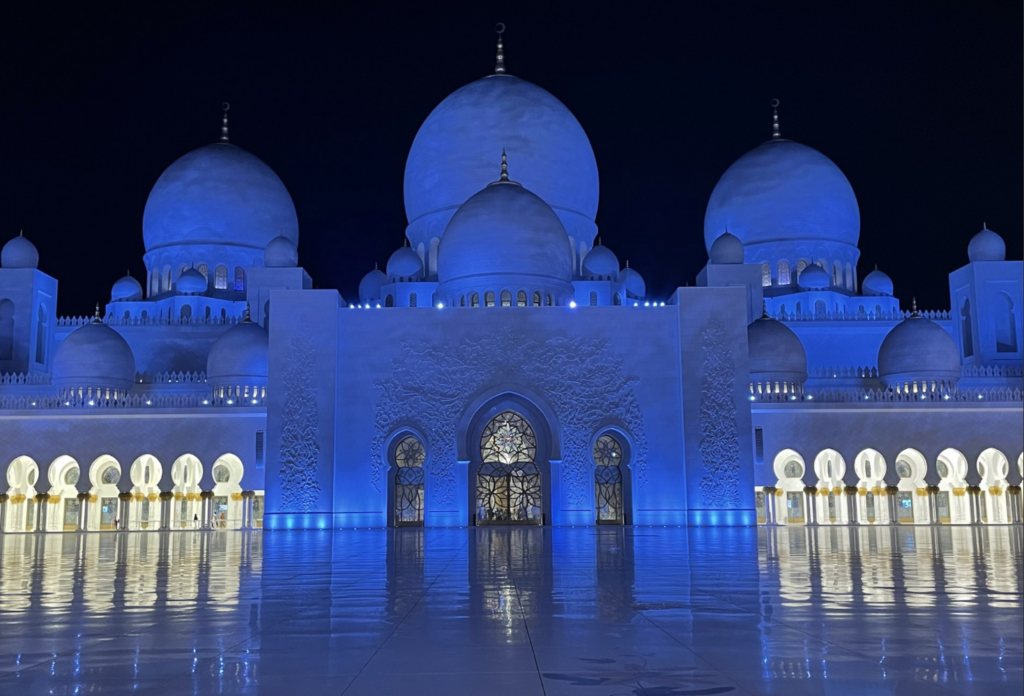
The Jean Nouvel designed Louvre is very different. I found it to be a highly successful example of modern architecture, which perfectly fits the Middle Eastern climate. It’s hard to get a good picture, as it looks best from the inside out:
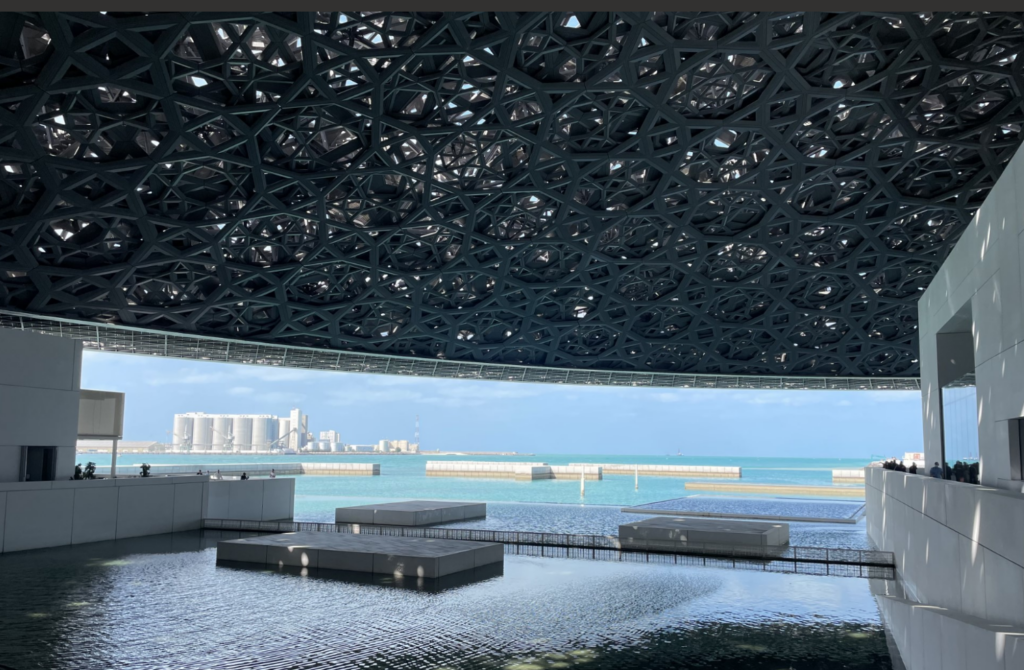
Like the (much bigger) Paris Louvre, the collection covers a wide ranges of genres and time periods. It’s a pretty good museum.
Not much more to say. Abu Dhabi isn’t super interesting, but it’s pleasant and has good food at reasonable prices. Great airport.
Oman: I knew relatively little about Oman, and was initially disappointed by the two hour wait at immigration. We spent two nights near Muscat, two in the desert, and two in the mountains. I say “near” Muscat, as Oman’s capital is a weirdly spread out place, due to the rugged mountains along the coast. Don’t make our mistake—get a hotel near the old town.
Oman is a slightly confusing place. Is it a middle income or high income country? The IMF has its (PPP) per capita GDP at just below $40,000, right next to Greece. But it actually feels like a developing country that’s pushed up to developed status by oil wealth.
The oil wealth seems to have been invested pretty wisely. The roads weren’t just good, they were outstanding. Most of the houses (outside old Muscat) that I could see looked reasonably large and modern. The styles ranged from simple white boxes to gaudy excess to art deco to cool modernism.
We drove south down the coast and hiked a pleasant “wadi”, which is an oasis-like stream in a mountain canyon. Lots of French tourists. We turned inland at Sur and experienced the only sketchy road, but we could see a new expressway under construction. Then we hit a brand new 6-lane expressway in the desert, and were almost the only car on the road—even in the middle of the day. The gas station was so new they hadn’t even opened the little mini-market or toilet on the site. I felt sorry for the two young men working in this god-forsaken place, who probably came from somewhere like Bangladesh.
The last 11 kilometers were across the desert to the desert camp, and at first we had trouble finding the “road”, which was just tire tracks in the sand. So I was sort of randomly driving in the general direction of the hotel (thank god for GPS.) Eventually we saw a car coming the other way and found the track. Despite the generally excellent roads in Oman, you’ll need 4 wheel drive in a few places. At the desert hotel, there are jeeps that will take you to the top of the huge dunes to watch the sunset, if you are too lazy to hike up. Recommended.
It’s probably hard to see, but our hotel camp is on the lower right, and there is a delegation of Saudi government people visible on a dune above the camp. In real life, the colors are absurdly vivid:
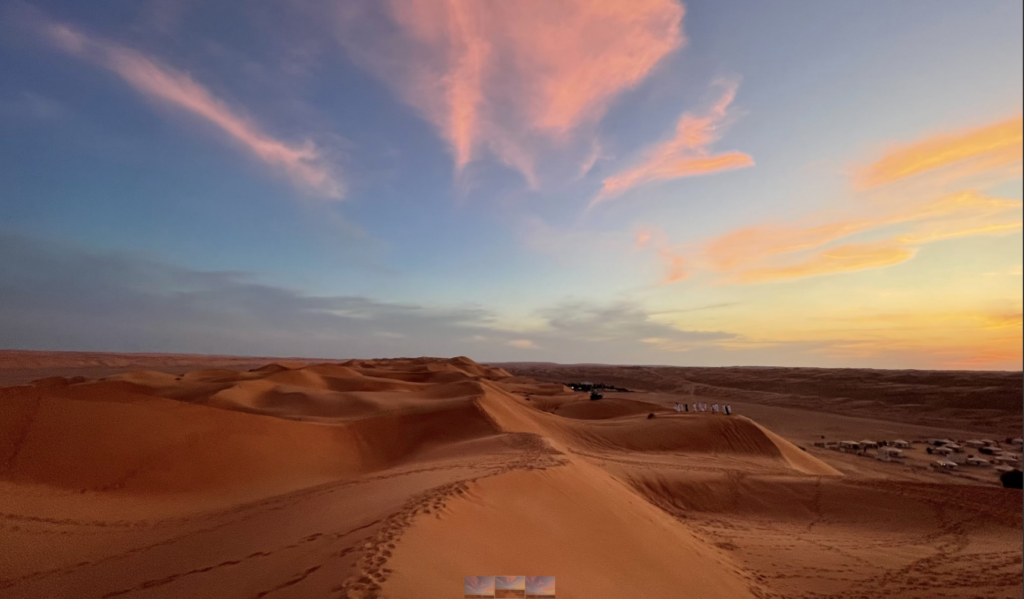
The third hotel was high up in the mountains. The Anantara Hotel was not the best hotel on our trip (that came later) but it was by far the most expensive (even though we got a discounted rate.) There are spectacular views and you can hike along a string of little villages perched on the edge of the giant canyon, with terraced fields below them where they grow things like roses. These villages are gradually becoming gentrified.
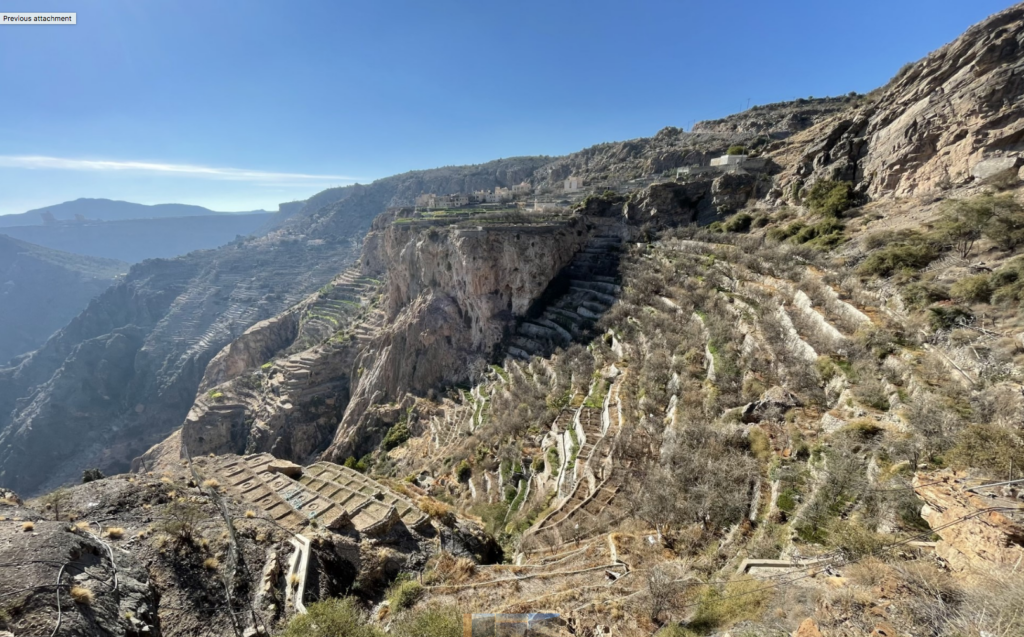
Overall, we had a positive impression of Oman. It’s much easier for tourists like me to navigate Oman than a country in a place like Latin America. Good roads, not crowded, good facilities, low prices, friendly people, very little crime. On the other hand, in some ways I’d rather visit a more “authentic” place, say Morocco, Turkey or Iran. Oman is safe, but a tad boring. The oddest thing we noticed is absurdly oversized police stations in almost every town. One was in a compound almost half a mile long, with several grandiose buildings. Maybe that’s why they have so little crime; every third Omani seems to work for the police.
Qatar: Qatar is even richer than Abu Dhabi, and looks it–perhaps only because it’s newer. It makes Florida seem like a state steeped in history. It also has a wonderful new airport, but unlike Abu Dhabi it’s very overcrowded, and thus you must take buses to and from the planes. (They are building a new terminal.)
Although they have a very nice new subway from the airport to the center of Doha, it doesn’t make any sense to use it. Take an Uber. But I wanted to see the subway, so not only did we take it, we paid triple to take a luxury “Gold” subway car. No one else did, as I later discovered than the ordinary cars are almost as luxurious. New Yorkers would trash these seats within 5 minutes:
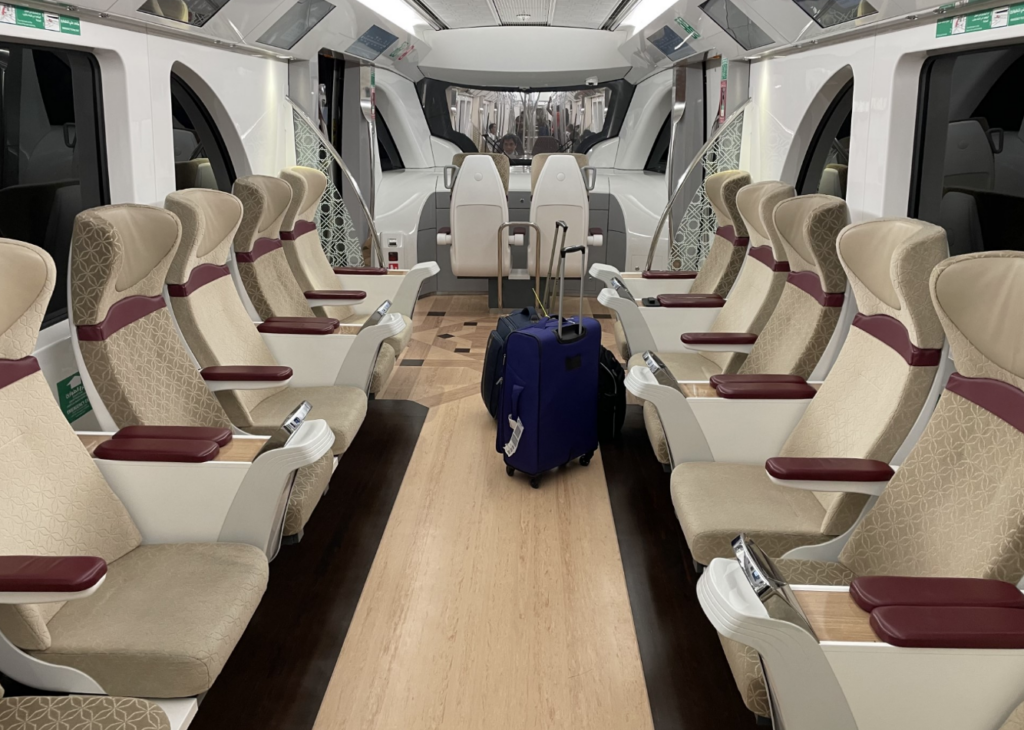
We stayed at the Mandarin Oriental, which was more luxurious than the Amantara, but found a discounted room at only $227/night. In a city like New York, the same hotel room is about $800/night. The first day I went to the spectacular Qatar National Museum, also designed by Jean Nouvel, but much less successful than his Abu Dhabi museum—the style is too “busy”. The collection is also mediocre. Imagine if a multi-generational business family spent a fortune on a museum of the family’s history, and filled it with knick knacks. OK, it’s not that bad, but let’s face it—Qatar is not a real nation. It built the museum to try to convince people that it has a rich history, but it doesn’t. It had 25,000 people back in 1950. There are Orange County suburbs with more than 10 times that number. Imagine a giant museum of the history of some place like Plano, Texas.
In other respects, Qatar is ahead of Abu Dhabi. The architecture mostly seemed better, and the Islamic Art Museum was spectacular—the best museum I saw on the entire trip. We had dinner at a fancy restaurant on the top floor of the museum. I generally find the Michelin star restaurants to be a bit pretentious and overpriced, and this was no exception. I preferred a meal we had in a Sri Lankan place in the fashionable Msheireb neighborhood near our hotel.
Tanzania: To say Tanzania was a change of pace would be an understatement. To begin with, it’s very poor (per capita GDP of $1327, or $3595 PPP) , even compared to nearby Kenya ($2188, and $6577 PPP). It was also quite green, although it was not the rainy season. It has 62 million people, but based on the green and fertile land I saw out the window, it could support a vastly larger population.
And soon it will! Most babies are now born in Africa and South Asia. That’s the future of the human race. Tanzania’s fertility rate is 4.7 per woman and falling, while Kenya is at 3.3 and falling. My driver had four children, while I have one. So who is more successful? It depends:
1. He’s having more success at the genetic level.
2. I’m having more financial success.
3. In utility terms it’s close, but he seems a bit happier.
We spent 8 days in Tanzania. The first night at Lake Manyara National park. Then a very long and bumpy drive to the Serengeti, where we spent 3 nights. Then back to Ngorongoro crater where we spent 2 nights. All three times we stayed at Serena hotels. We ended up staying 2 nights at a tent camp in Tarangire National Park.
If I could do it all over, I’d cut out Manyara, and start with Tarangire. I’d also stay closer to the entrance to Tarangire, as it was an uncomfortable 1.5 hour drive from the entrance to our camp, and most of the animals that we saw the next day were close to the entrance (at this time of year.) BTW, I think this is an excellent time of year to visit.
I have mixed feelings about the trip. Due to bad water, I suffered a lot of discomfort during the last couple days, on the long trip home, and even after getting home. But I also had some of the best travel days of my life, especially in the Serengeti and Ngorongoro areas. Most people go to see the animals and to a lesser extent tribal groups like the Maasai. I’m unusual–much more interested in landscapes than in animals and people (although I did enjoy seeing the animals and meeting the Maasai.)
There were times when the spectacular landscapes made me feel much younger. At the risk of sounding like Burt Lancaster in Local Hero, even the sky was amazing.

But most people come for the animal life, which gets quite close to the jeep:
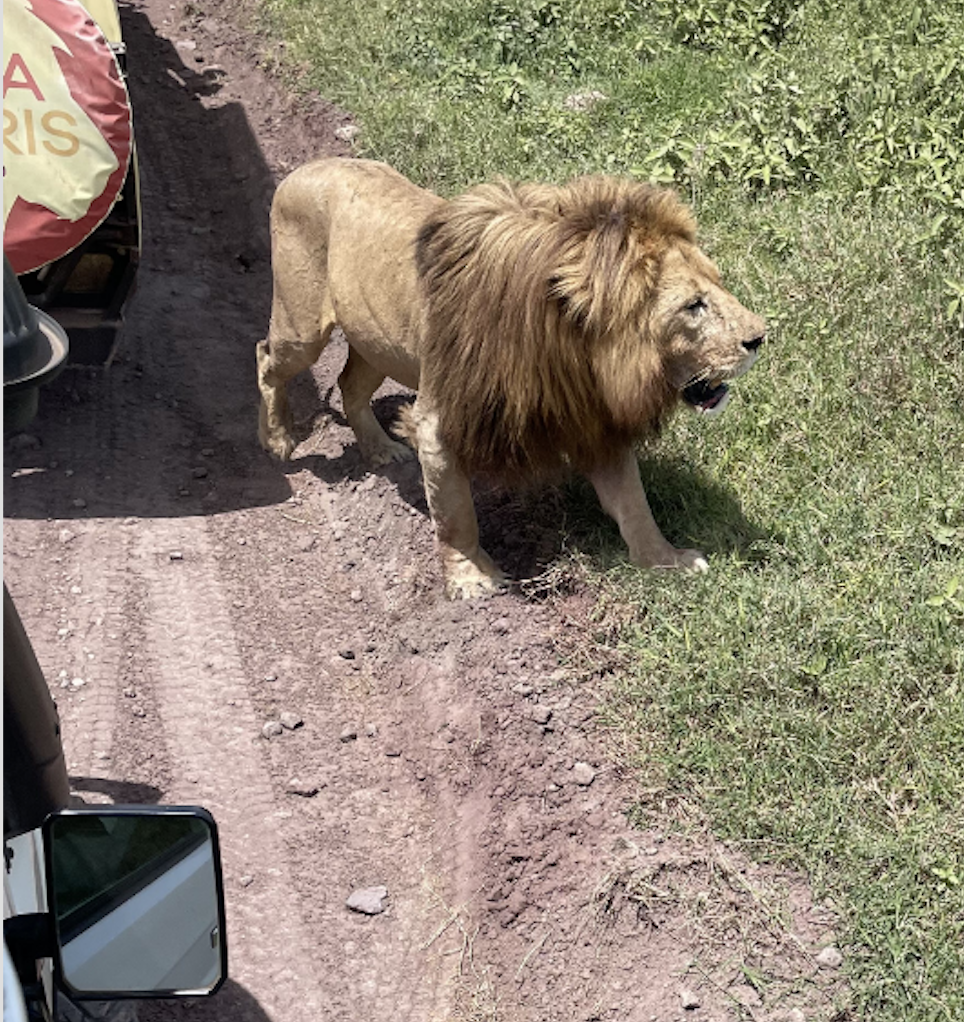
We used Fortis safari company. The driver named Robert was very knowledgeable and quite personable. At the hotels, you get escorted to your room after dinner (generally a separate bungalow or tent), as the hotel doesn’t wish to have their customers eaten by lions.
The long trip home reminded me of the film Three Times, directed by Hou Hsiao-hsien. That film presents the same love story three times, using the same actors. The first episode occurs during the 1960s, and is obviously close to the director’s heart. The second is a silent film, taking place around 1910. Life is too repressive. In the final segment you are in a neon-lit future, where people are free but rather apathetic and alienated.
On the first of three consecutive nights, I stayed in a tent in a remote area of Tarangire park—not free to walk outside at night. The next night we were in massive Doha airport, which is a highly artificial environment packed with people from all over the world. Even at 1am the place was very crowded. We stayed right in the terminal in a tiny 5-foot by 6-foot room with a bunk bed, which had no windows—kind of like those futuristic Japanese capsule hotels. It cost almost as much as our luxurious Mandarin Oriental room. The third night we stayed at our spacious and pleasant home in Mission Viejo, which overlooks a lake and some mountains. In some odd way, I felt the primitive tent and the futuristic airport pod bookended our familiar house in OC in much the same way that the final two segments of Three Times bookended Hou Hsiao-hsien’s nostalgic memories of the 1960s.
PS. Even though I had already gone through security, there was another security checkpoint right at our gate for the 16 hour flight from Doha to LA. I was outraged that I couldn’t take a bottle of water with me, which I like to have on long flights. The agent told me to blame the TSA. Even on the other side of the world, the US government is screwing up my life.
Other passengers must laugh as they walk by gates where flights to America are boarding: “Those Americans are so risk averse that the security measures used in all other countries aren’t good enough for them.” It’s bad enough that the TSA imposes the excessive security theatre on American airports, now they demand that foreign airports serving America follow suit. So Doha must set up special gates for neurotic Americans. Pathetic.
Please abolish the TSA and let each American airport contract out security to the firm of its choosing. Let foreign airports set their own standards. Stop the madness.
PPS. In fairness, my Global Entry card worked well, so the US can do a few things right.